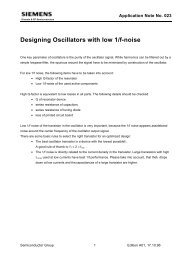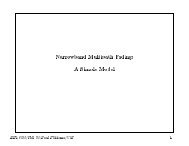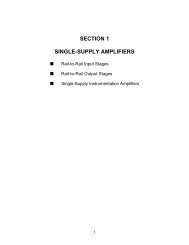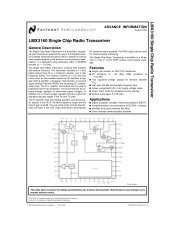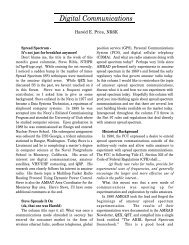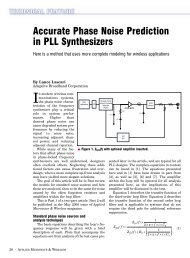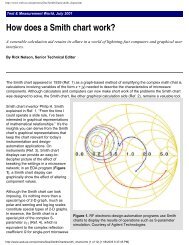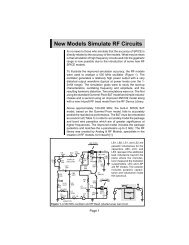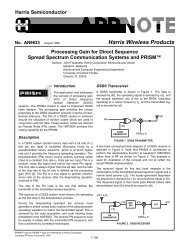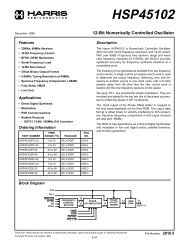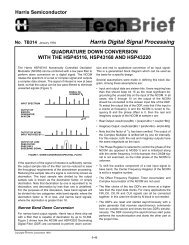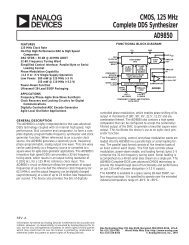AD7008 CMOS DDS Modulator
AD7008 CMOS DDS Modulator
AD7008 CMOS DDS Modulator
Create successful ePaper yourself
Turn your PDF publications into a flip-book with our unique Google optimized e-Paper software.
<strong>AD7008</strong>When amplitude modulation is not required, the IQ multiplierscan be bypassed (CR = 2). The sine output is directly sent tothe 10-bit DAC.Digital-to-Analog ConverterThe <strong>AD7008</strong> includes a high impedance current source 10-bitDAC, capable of driving a wide range of loads at differentspeeds. Full-scale output current can be adjusted, for optimumpower and external load requirements, through the use of asingle external resistor (R SET ).The DAC can be configured for single or differential-endedoperation. IOUT can be tied directly to AGND for single-endedoperation or through a load resistor to develop an output voltage.The load resistor can be any value required as long as thefull-scale voltage developed across it does not exceed 1 volt.Since full-scale current is controlled by R SET , adjustments toR SET can balance changes made to the load resistor.DSP and MPU InterfacingThe <strong>AD7008</strong> contains a 32-bit parallel assembly register and a32-bit serial assembly register. Each of the modulation registerscan be loaded from either assembly register under control of theLOAD pin and the Transfer-Control (TC) pins (See Table II).The Command register can be loaded only from the parallel assemblyregister. In practical use, both serial and parallel interfacescan be used simultaneously if the application requires.TC3–TC0 should be stable before the LOAD signal rises andshould not change until after LOAD falls (Figure 2).The DSP/MPU asserts both WR and CS to load the parallel assemblyregister (Figure 3). At the end of each write, the parallelassembly register is shifted left by 8 or 16 bits (Depending onCR0), and the new data is loaded into the low bits. Hence, two16-bit writes or four 8-bit writes are used to load the parallel assemblyregister. When loading parallel data, it is only necessaryto write as much data as will be used by that register. For instance,the Command Register requires only one write to theparallel assembly register.Serial data is input to the chip on the rising edge of SCLK, mostsignificant bit first (Figure 4). The data in the assembly registerscan be transferred to the modulation registers by means ofthe transfer control pins.Maximum Updating of the <strong>AD7008</strong>Updating the <strong>AD7008</strong> need not take place in a synchronousfashion. However, in asynchronous systems, most of the externalclock pulses (LOAD and SCLK) must be high for greaterthan one system clock period. This insures that at least oneCLOCK rising edge will occur successfully completing the latchfunction (Figure 1).However, if the <strong>AD7008</strong> is run in a synchronous mode with thecontrolling DSP or microcontroller, the <strong>AD7008</strong> may be loadedvery rapidly. Optimal speed is attained when operated in the16-bit load mode; the following discussion will assume thatmode is used. Each of the modulation registers require two 16bit loads. This data is latched into the parallel assembly registeron the falling edge of the WR command. This strobe is notqualified by the CLOCK pulse but must be held low for a minimumof 20 ns and only need be high for 10 ns. The two 16-bitwords may be loaded in succession. While the second 16-bitword is being latched into the parallel assembly register, theTransfer and Control word may be presented to the TC3–TC0pins. If the designation register is always the same, an externalregister can be used to store the information on the inputs ofTC3–TC0. At some time after the second falling edge of WR,the LOAD signal may go high. As long as the load signal is high5 ns (see setup time) before the rising edge of the CLOCK signal,data will be transferred to the destination register.The limiting factor of this technique is the WR period which is30 ns. Thus the CLOCK may run up to 33 MSPS using thistechnique and the effective update rate would be one half or16.5 MHz. See timing Figure 10 for timing details.DATAWRCLOCKTCLOADHI WORDLOW WORDFigure 10. Accelerated Data Load SequenceAPPLICATIONSSerial ConfigurationData is written to the <strong>AD7008</strong> in serial mode using the two signallines SDATA and SCLK. Data is accumulated in the serialassembly register with the most significant bit loaded first. Thedata bits are loaded on the rising edge of the serial clock. Oncedata is loaded in the serial assembly register, it must be transferredto the appropriate register on chip. This is accomplishedby setting the TC bits according to Tables II and III. If youwant to load the serial assembly register into FREQ1 register,the TC bits should be 1101. When the LOAD pin is raised,data is transferred directly to the FREQ1 register. When operatingin serial mode, some functions must still operate in parallelmode such as loading the TC bits and updating the Commandregister which is accessed only through the parallel assemblyregister. See Figure 11 for a typical serial mode configuration.+5VU21450MHzV CC8OUTV EE7K1115WRLOADSCLKSDATARESETCMD0CMD1CMD2CMD3TC0TC1TC2TC319202122232425268910111213141516273233343536414231303837D0D1D2D3D4D5D6D7D8D9D10D11D12D13D14D15WRU3<strong>AD7008</strong>CSTC0TC1TC2TC3LOADSCLKSDATAFSELECTCLKRESETSLEEPC16V REF+5V0.1µF C25+5VCOMP0.1µF2 R4IOUT149.9R3IOUT49.9FSADJUSTV AAV DDV DDV DDAGNDDGNDDGNDDGNDDGNDTEST4317283944718294340R5390+5V+5V+5V+5VFigure 11. General Purpose Serial InterfaceREV. B –9–



